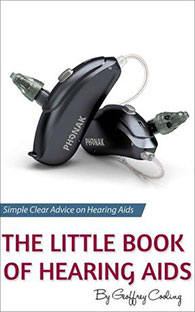It is clear from many of the things I have heard from many people across the world, both professionals and users, that the Oticon Opn is a pretty good hearing aid system. Steve's recent article "Superb hearing experience in restaurants with Oticon's OPN hearing aids" just went to confirm what has been said about the devices. Oticon say it is a brand new and innovative strategy, having discussed the features with one of their representatives, I am inclined to agree. So what do you need to know about Oticon Opns?
Confusing But Worth It
Firstly, if you are an experienced user of hearing aids and you wish to try out the Opn, it is important that you understand that this is unlike anything you may have tried before. All of the reports including Steve's conversations with me point to the fact that initially, the sound presentation is confusing, odd, even overwhelming. If you are a new user, any hearing aid can be confusing, odd and even overwhelming.
![]()
Stick With It, The Brain Needs Time
However, the brain (your one) will adapt to it over a varying period of time,it may be two weeks, it may be a month. The adaptation period seems to vary a little from person to person. But the brain will adapt and that is when the hearing aids will come into their own.
Getting The Full Picture
Oticon continually talk about an "Open Experience" and giving the full sound picture. They say that this is at the core of their new hearing aid strategy and what makes the difference. Deciphering the marketing language is what we try to do here, we also try to turn the gobbledygook of technical language into easily understandable language. I don't often feel over taxed doing this, however, there is always a first time right? So here goes, try my best, because this actually excites me and it really seems to be a whole new way to deal with sound.

Confused About The Right Hearing Aid For You?

Our buying guide, easing the confusion with clear easy to understand info, we guarantee it will help you pick the right hearing aid for you.
Delivering All Speech, Attacking The Noise
What Oticon is doing is very different to what anyone else is doing when it comes to the over riding strategy. They have changed the way directionality (directional microphones) is used and the way speech is handled. In essence, the hearing aids are always providing a full view of your surroundings. But they present all speech and noise in different ways and with different strategies.
Without getting too technical, all speech from the sides and front are presented to you for best audibility. All speech from the rear is also presented to you for audibility but at a lower level of volume. Steve described this in his article, what he said was that instead of the wall of noise or babble he was used to, he could discern and pick out conversations all around him.
He didn't know what they were saying and he didn't need to, but he could discern the nuances of speech and conversations. Oticon believe that following this strategy delivers the best and most natural sound picture to your brain. It makes sense, natural hearing delivers exactly this sound picture to us. So what they are delivering is a nuanced sound picture when it comes to speech, but what about noise?
Attacking The Noise
They still attack noise, handling it in a different manner to speech. This is where it gets a bit technical, but stick with me, I will try. The standard way to deal with noise across all of the manufacturers is to identify it and attack it through directional microphones and special processing features. Oticon is doing it differently, they aren't using what you would call a traditional directional strategy. The traditional directionality strategy is to focus the microphones to the front. That's where the speech usually is right?
Using this strategy is changing the natural sense of things, but it works really well. Oticon aren't using a traditional directionality strategy, they are using the understanding of localisation and analysis of noise to attack the noise in both traditional and non traditional ways. In essence, they are using the beneficial effect of directionality without focusing the microphones to the front. Confused much?
Directionality and The Null
Directionality works by applying a null, that means an area that is ignored by the processing and the microphones. Oticon are using the null and applying it in the processing to reduce the effect of noise. In fact, the top of the range Opn 1 can do this with sixteen different noise sources and react to their changing state. This strategy, combined with the way they are handling speech from all angles delivers the more natural sound picture and the cues that they believe your brain needs to work it all out.
Speech from everywhere combined with the art of directionality, without the directionality! Confused Much?
I think Steve described it perfectly when he said that he is used to hearing a wall of noise. By that he didn't mean an overpowering sensation, he meant simply a solid background of un-discernable noise. What the Opn seems to deliver is a much more nuanced sound picture, where the background speech is discernable and nuanced, but the background noise is still controlled. I think it is the first time I have ever heard somebody describe their experience like that.
I would never have been a fan of Oticon as a manufacturer, I never believed in the directionality strategy that they used in the past. However, I have had to readjust my thinking, the word on the street as it where, was that the Opns were really successful. So I decided to take another look, the new strategy they are using is radically different from before. In fact it seems to be highly different than anyone else.
The strategy is fascinating and they say that it is the new chipset and its speed that allows them to deliver it. Steve's experience speaks for itself really, I hope to get a hold of the aids soon so I can play with them. I will follow up with some more technical explanations of the features over the next while.
Posted by Geoff

Geoffrey Cooling





Geoffrey (Geoff, anything else makes him nervous) Cooling has been involved with the hearing aid industry for over ten years. He has worked in private practice dispensing hearing aids and as a manufacturer's rep. He has written two books and they are both available on Amazon. He loves technology, passing on knowledge and is legendary for many other things, primarily the amount he curses, his dry and mischievous sense of humour and his complete intolerance of people who are full of themselves. Please feel free to connect with him
If you like what you see, share it so others can benefit
Looking For the Latest Hearing Aids or A Hearing Test?
Arrange a consultation with a trusted Independent hearing healthcare professional in your area



